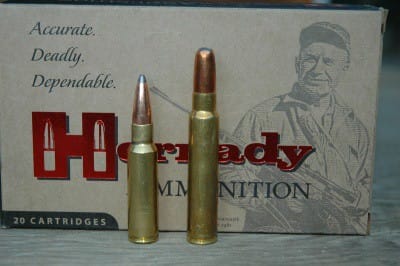
The .375 Ruger is a very good cartridge, and in several different ways. It performs a bit better than the great old .375 H&H, but it uses a shorter .30-06-length (2.5 inches) case, enabling it to be housed in shorter, more compact, and often less expensive actions. One could perhaps argue that we did not need more competition in the power/performance niche occupied by the .375 H&H, but that point can be discussed.
One thing I really liked about the .375 Ruger was its case. It was not based on an existing design, although the dimensions are familiar. Almost all of our standard belted magnums are based on the .532-inch rim and belt diameter of the .375 H&H. Hornady’s engineers, in cooperation with Ruger, took that very standard dimension and used it as the rim and base diameter, creating a straight, unbelted case that obviously has more case capacity than a belted magnum with that rim diameter—but not quite as much as the Remington Ultra Mag (and Short Action Ultra Mag) and Winchester Short Magnum (and Super Short Magnum) families, which are based on larger diameter cases.
Since case capacity ultimately determines performance, and since we know “short and fat” creates burning efficiency, the slightly skinnier case of the .375 Ruger seems to take a step back, maybe. Except that part of the concept was to create a cartridge that was manufacturer-friendly. With the .375 Ruger case a rebated rim is not required, standard belted magnum bolt faces work, and smooth feeding is generally accomplished without modification of the rails or magazines boxes.

The concept was sound, and it was obvious the .375 Ruger case would be used for additional cartridges in different calibers. Personally I predicted a .338 Ruger, and perhaps a .416 Ruger. The latter has come to pass, the former not. But I was totally surprised by the first progeny of the .375 Ruger. Introduced simultaneously, they are the .300 and .338 Ruger Compact Magnums. The concept is simple: Shorten the .375 Ruger case to .308 Winchester length (2.015 inches), neck down to .300 and .338. That is it.
With both the WSM and RSAUM families of short magnums on the market (with some cartridges failing, others doing okay), did we really need two more short magnums? Perhaps not, but the concept behind the RCMs is not purely about marketing hype; ease of manufacture is part of their credo. Originally introduced the short-action Ruger M77, the RCMs really do feed smoothly and reliably. We do not talk about it much, but feeding is often an issue with the short magnums based on fatter cases.
A wee bit of performance is surrendered to the more slender case, but a fair amount of this is regained through Hornady’s propellant technology. Starting with their “Light Magnum” and “Heavy Magnum” lines and continuing through LeveRevolution and the .375 Ruger itself, Hornady has been a leader in experimenting with new propellants that deliver more energy without increasing pressure. The .300 and .338 RCMs definitely do this. Hornady’s initial factory loads for the .300 RCM feature a 150-grain SST at 3,170 fps, and a 180-grain SST at 2,900 fps. Since then a 150-grain GMX and 165-grain SST have been added. Loads for the .338 RCM are 200-grain at 2,850 fps and 225-grain at 2,710, both the aerodynamic SST bullets. These figures are very close to standard velocities for the .300 and .338 Winchester Magnums, fantastic performance from such small cases.

There are limitations. At some point case capacity tells. With bullet weights above 180 grains in the .30 and above 225 grains in the .338 the RCMs start to fall behind. Also, it’s only fair to point out that Hornady is using powders that are not currently available over the counter, so it will be very difficult for handloaders to come up to factory performance for these cartridges.
These facts aside, the RCMs are both manufacturer-friendly and user-friendly. On the range I have been impressed by their accuracy, and in the field I have been impressed by their performance. I have often written that we now have too many new cartridges for the market to absorb, and not all can succeed. Both RCMs are good cartridges well worth considering. Their success is up to you.



